Acute. Later, rehabilitation
By the end of the 19th century Finchley had a population of some 33,000. The need for a local hospital had been identified during the Queen's Jubilee in 1897 but, after seven years, nothing had been done about it. A group of local residents therefore decided to take the initiative and establish one.
They held their first meeting in 1904 in a room above Mr E Danby's saddlers shop at 59 High Road, North Finchley (Mr Danby later became one of the Hospital's committee members). Eight people were in attendance.The estimated cost of the Hospital building was £5,000. Money was raised by committees of residents, businessmen, door-to-door canvassers and amateur dramatic performances, as well as circular letters by the Rate Payers' Association. A Working Men's Cottage Hospital Fund raised £169.
A local benefactor, Ebenezer Homan, offered to buy the site for the Hospital if the money for the building could be raised by 1907.
A 2-acre site at Fallow Corner, at the junction of Bow Lane and Granville Road, was acquired from the Ecclesiastical Commissioners for £1,000. Mr Homan also gave £5,000 in Metropolitan Water Board 3% stock, and paid for the entrance lodge and gates of the new Hospital.
The Finchley Cottage Hospital was officially opened on 28th May 1908 by Mr Homan, the President of the Hospital. It had 20 beds - 10 for men in one ward and 8 for women in another, 2 separate rooms for isolation cases and a small operating theatre. Two of the beds had been paid for by money raised at the Hospital Carnival (which continues today as the Finchley Carnival).
In 1911 a proposal was made to lay a railway line through the grounds of the Hospital. Supported by a Council representative in Parliament, the Hospital Committee objected and the scheme was rejected.
At the outbreak of WW1 the Hospital was asked by the War Refugee Committee to provide treatment for sick Belgian refugees. This it did, in addition to carrying on its own work. Later in the war it also treated, free of costs, any sick relatives visiting injured soldiers convalescing at King Edward Hall Auxiliary Hospital and Summerlee Auxiliary Hospital. In 1916 an X-ray Department was installed.
After WW1 the population of the area grew rapidly and the local council decided to build an extension to the Hospital as a War Memorial to those local men who had died in the war. An Appeal was launched for funds and, by the beginning of the 1920s, some £22,000 had been raised.
By 1922 the extension was complete; the Hospital had 47 beds and a Nurses' Home had been built. The War Memorial extension was dedicated in November 1922 by General Sir Ian Hamilton, and the Hospital was renamed Finchley Memorial Hospital.
The new female ward with 16 beds was named the Woodrow Ward, after Mr E.A.E. Woodrow, the Honorary Architect and Honorary Secretary of the Hospital. The new male ward with 10 beds was called Homan Ward, after Ebenezer Homan, the Hospital's benefactor who had died in 1909. The children's ward, with 10 cots and 2 beds, was named Summerlee in commemoration of the Summerlee Auxiliary Hospital, which had been commanded by Dr T.W. Hicks, M.B.E., J.P., a member of the Hospital's staff who had been involved in the Appeal. (When Summerlee closed, its Committee and the subscribers donated the contents of a 20-bed unit and some operating theatre equipment to the Hospital, in addition to a donation of £1,000 to the Hospital Extension Fund). Visiting time to the children's ward was from 2 o'clock to half past 3 on Sunday afternoons only. The new extension also had a private ward with 9 beds.
The nursing staff consisted of a Matron, 4 Staff Nurses and 7 probationers. A cook, a kitchen maid, a ward maid and a few servants undertook the domestic duties. The old original children's ward was refurbished for use as a Staff Dining and Recreational Room.
In 1923 two more acres of land were purchased at a cost of £2,000 in anticipation of future extensions.
A Linen League was inaugurated in 1925. The League provided the Hospital with its sheets, pillow cases and other bedding, as well as tea cloths, tray cloths, towels and night garments for the patients. The Surgical Working Party, which met fortnightly, made bandages, knitted dish cloths, pneumonia jackets, operation caps for the surgeons and nurses, swabs, slings and splints. The Hospital Working Party provided bedpan covers, bowl cloths, male and female operating gowns and surgeons' coats, as well as children's nightgowns and sundries.
In 1926, because of the increasing number of road traffic accidents (the Hospital was located by two main roads), a Casualty Department was built. It had a separate entrance from the main Hospital, its own operating theatre, one male ward (Walter Cope ward) and one female ward (Mary Curtis ward), giving the Hospital 8 extra beds. The new Department, which also had its own X-ray facilities, was officially opened in February 1927 by Lady Barratt.
In 1930, when the population of Finchley had almost doubled to 62,000, more extensions were planned.
In 1933, a new 2-storey block was built. This contained a new Nurses' Dining Room, staff sitting rooms and 14 bedrooms for staff accommodation. A 3-storey private wing was also built, at a cost of £20,000 for the building and its equipment. It contained 26 private rooms on two floors and a Solarium, with 14 rooms for nurses on the top floor. Private patients were charged between 4-7 guineas (£4.20-£7.35) a week. The new extensions were opened in March 1933 by Lord Horder, who also joined the Honorary Consulting Staff.
The Hospital then had 72 beds. The medical staff comprised 12 Honorary Consulting Staff and 27 Honorary Medical Staff. A Resident Medical Officer was appointed.
During 1937 the Linen League's Mending Party mended 1,016 articles and the League contributed 1,268 items valued at £129 11s 8d (£129.58), compared to the previous year, when 868 articles were made at a value of £106 7s 6d (£106.37).In 1939 a new mortuary was built. In the same year a nearby house was rented for staff accommodation from Miss Blanche Wright of the Wright-Kingsford Home for Children.
The cost of an in-patient per week in 1939 was £4 15s 4d (£4.77), compared with £4 8s 9d (£4.44) in 1938, £4 2s 3d (£4.11) in 1937 and £3 17s 2d (£3.86) in 1936. The average length of stay was 17 days. The Hospital had 13 Honorary Consulting Staff and 29 Honorary Medical Staff.
At the outbreak of WW2 the patients were evacuated (resulting in a lack of income) and the Hospital joined the Emergency Medical Scheme, with 70 beds made available for air-raid casualties (by 1944 this had increased to 84 beds). Some £2,000 (most of which was provided by the government) was spent on strengthening and protecting the buildings. Emergency heating and lighting was purchased in view of the initial emergency conditions, together with stocks of dressings, splints, certain drugs and foodstuffs. Mrs J.E. Crowder, the wife of the Hospital's President (and MP for Finchley - he was succeeded by Margaret Thatcher in 1959), placed her house in Hampshire at the Hospital's disposal for use as an auxiliary hospital for 40 patients. A self-contained apartment block was leased and furnished for extra staff accommodation.
The Hospital joined the NHS in 1948 under the control of the Barnet Group Hospital Management Committee, part of the North West Metropolitan Regional Hospital Board. The buildings were redecorated and newly equipped, and plans were made to extend the Hospital from 84 beds to 200.
By 1950, however, beds had to be closed because of staff shortages.
In 1956, when the Hospital had 76 beds, plans were made for a new ward block, Casualty Department and Out-Patients Department. When these were completed, accommodation could be provided for the nurses who were housed in the apartment block outside the Hospital.
In 1957 the League of Friends for Finchley Hospitals was founded to support two hospitals in the area - Finchley Memorial Hospital and St Elizabeth's Home in Mayfield Avenue.
In 1958 new X-ray and Physiotherapy Departments were opened by Cllr George W. Reed, J.P., Mayor of Finchley.
The League of Friends raised funds to build and equip a Chapel and rest room, which opened in 1962.
In January 1962 work began on new larger Casualty and Out-Patients Departments, which opened in 1963. The X-ray and Physiotherapy Departments were improved, and Day Rooms were added to the Homan and Woodrow Wards.
In 1974, following a major reorganisation of the NHS, the Hospital's Ear, Nose and Throat Department closed. With only 13 beds it was deemed too small by the Department of Health. When the new operating theatres opened in Barnet General Hospital, all surgical work was transferred there and the Hospital's operating theatres were also closed. The Hospital pharmacy closed when the service became centralised. The Casualty Department was also threatened with closure but the lack of alternative facilities ensured its future for the moment (it later survived as the Minor Injuries Unit).
In 1979 when St Elizabeth's Hospital closed, the League of Friends for Finchley Hospitals changed its name to the Friends of Finchley Memorial Hospital.
The Chapel closed in 1980; it was hardly used as patients were usually too ill to attend and chaplains held services on the wards instead. The building briefly became a Mother and Baby Clinic in 1982, and then was set up as a wheelchair clinic.
In the mid 1980s, when it was under the control of the Barnet Health Authority, all acute medical work at the Hospital was transferred to Barnet General Hospital. The Hospital was then redesignated as a hospital for care of the elderly.
A Geriatric Day Hospital with 30 places was officially opened in January 1987 by Margaret Thatcher, then Prime Minister and the Member of Parliament for Finchley. The Hospital then had 90 beds in four wards named George Brunskill, Marjory Warren, Fallowfield and Dickens wards. The Friends had donated a glazed conservatory overlooking a triangular garden.
In 1991, after yet another NHS reorganisation, the Hospital became part of the Barnet Healthcare NHS Trust. Fallowfield Ward with 14 beds was closed, while Dickens Ward was designated for patients needing continuing care due to long-term illness and George Brunskill and Marjory Warren wards were for patients needing respite care and rehabilitation. The Hospital continued to provide out-patient services, including clinics, diagnostic and clinical investigations and various therapies.
In 2001, after another NHS reshuffle, the Hospital came under the control of the Barnet Primary Care Trust, which was also responsible for the Edgware Community Hospital.
In 2004 a £1m Walk-In Centre opened to treat minor injuries and illnesses.
In 2007 the Hospital was deemed "not fit for purpose" and plans were made to redevelop the site, including the relocation of the Marie Foster Centre in Wood Street.
Present status (June 2008)
Still active as a Primary Care Trust (PCT) hospital, The Hospital provides services for several Trusts, including Barnet PCT, Barnet and Chase Farm Hospital NHS Trust, North West London NHS Trust and the Royal Free Hampstead NHS Trust.
The Hospital has 56 beds in two wards managed by consultants from Barnet Hospital, Northwick Park Hospital and Royal Free Hospital (who also hold out-patient clinics on the site). Marjory Warren Ward with 28 beds is for patients needing rehabilitation after orthopaedic treatment in an acute hospital, and George Brunskill Ward with 16 beds for rehabilitation patients and 12 specialist beds for recovering stroke patients. (Dickens Ward with 20 beds for those needing continuing care closed in 2008 and the patients were transferred to local nursing homes.)
As well as out-patient clinics, the Hospital provides services such as physiotherapy, occupational therapy and podiatry. There is also a Walk-In Clinic for minor injuries and illnesses.
In 2008 NHS Barnet purchased the disused Bow Lane Playing Fields from the London Borough of Camden. The 9 acres is adjacent to the Hospital and it is planned to build the new community hospital on half the site (some space would be retained for future expansion), enabling the current buildings to remain open during the building works.
Update: June 2010
Planning permission was granted in January 2010 and it was anticipated that work would begin on the new £40m Hospital in July or August 2010 and would be completed by 2012.
The new community health facility is to provide specialist rehabilitation and intermediate care, as well as primary care services, therapies and out-patient clinics. It will also include the Marie Foster Centre for patients suffering from multiple sclerosis and other neuro-degenerative diseases. There will also be a cafe and a retail unit.
Once the new facility is operational, the current buildings will be demolished. Part of the cleared site will become a car park for the new facility, and the surplus sold for residential development.
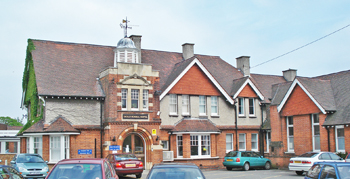
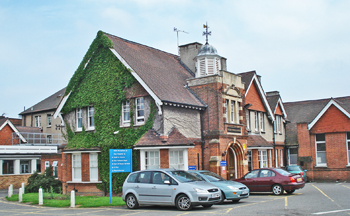
The original Finchley Memorial Hospital has had buildings added to it progressively over the decades.

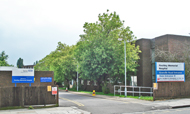
The main entrance on Bow Lane (left) and the side entrance on Granville Road (right).

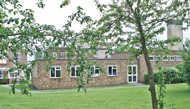
The new Walk-In Clinic (left) and a new block (right).
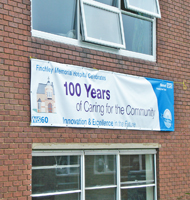
The Hospital celebrated its centenary in 2008.
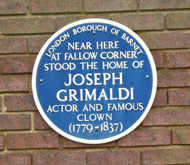
A blue plaque to the great clown Joseph Grimaldi is attached to one of the modern buildings.
"At some time in the summer of 1948 or 1949, I was a little boy of 4 or 5 living in Fallowcourt Avenue, just a short distance from the Hospital.
A bunch of kids were racing their scooters and tricycles along the street (no cars either parked or moving in those days) and I made a mistake, came off my tricycle and smashed my left elbow on the edge of the kerb. Much screaming and tears and my Mum rushed me the short distance to the Hospital. After that I don't remember much until I was aware that my arm was in a plaster with my fingers touching the right side of my neck. It seems that I broke the elbow end of all three arm bones.
Things had apparently not gone well, because I very, very clearly remember being in the men's ward and seeing the gas machine behind being wheeled into the ward. I must have had a memory of something because, on seeing this thing, I screamed the place down. I had to be held down whilst being anaesthetised and, when I woke again, nothing seemed to have changed. However, I gather that the first setting had not worked and that my arm had to be broken and reset again.
My other memories are of being 8 weeks in the children's ward, the kindness and fun of the nurses, being given what may have been the first Airfix kit of a tractor, and of biting the end off a thermometer for some reason.
Then, when the plaster came off, it would seem that everything had healed nicely because I went home and started about 3 months of physio. At first I could barely bend my elbow by an inch and it was a full 3 months before I could straighten my arm. But being only very young I suppose helped a lot and I have never suffered any lack of mobility or pain in my life - not a bad outcome.
So I got lucky and the skill of the staff in those far-off days certainly worked for me.
As an afterthought, I had a big mental hurdle to cope with when I started training to be a pilot in the Royal Air Force - rubber oxygen mask, you see. But all was OK and I earned every meaningful wage in the air all my working life."
Geoff Matthews, 27th March 2017
(Author unstated) 1906 Finchley Cottage Hospital. British Medical Journal 2 (2379), S147.
(Author unstated) 1907 Reflections from a Board Room mirror. British Journal of Nursing 31st August, 172.
Dressekie D 2008 Finchley Memorial Hospital: The First Century. London, ACW Ltd.
http://hospitalshistory.multiply.com
www.barnet.gov.uk (1)
www.barnet.gov.uk (2)
www.barnetlink.org
www.barnet.nhs.uk (1)
www.barnet.nhs.uk (2)
www.barnet.nhs.uk (3)
www.barnet.nhs.uk (4)
www.barnetpct.nhs.uk
www.british-history.ac.uk
www.francestobin.com
www.geograph.org.uk
www.images-of-london.co.uk
www.the-archer.co.uk (2008)
www.the-archer.co.uk (2009)
www.times-series.co.uk
Return to home page